
views
X
Research source
With a fair amount of patience and persistence, you can train your dog to be calmer so you can best enjoy each other's company.
Teaching Your Dog to Behave Indoors

Establish indoor 'ground-rules' with your dog. Decide what sort of behavior your want your dog to exhibit while indoors and work toward correcting behavior that doesn't fit with your expectations. If you are consistent with the boundaries you set, your dog will soon catch on. Do you want him to be completely still and quiet in the house? Is it okay for him to bark when he sees a squirrel outside? Focus on rewarding positive behavior rather than punishing bad behavior. Give your dog a small treat or a chew toy when he is being calm. Stick to your own rules by not rough-housing with your dog or riling him up on purpose. Deciding on a whim that it is okay for your dog to act crazy when you usually discourage this will only confuse him.

Ignore your dog's bad behavior. Although this may seem counter-intuitive, it really works. When your dog misbehaves (steals a shoe, barks, or jumps up on you), he is trying to get your attention. By acknowledging him, even in a negative way, you are reinforcing his actions. Try ignoring him when he does something wrong; this means no eye contact, no verbal communication, and no physical contact. Once your dog settles down, reward his calmness with attention. This will teach him that it was only once he relaxed that he got what he wanted from you. If you encounter a situation you can't ignore (for instance, your dog has your child's favorite doll in his mouth), get your dog to stop by distracting it with a toy. Once it stops, give it the toy as a reward.
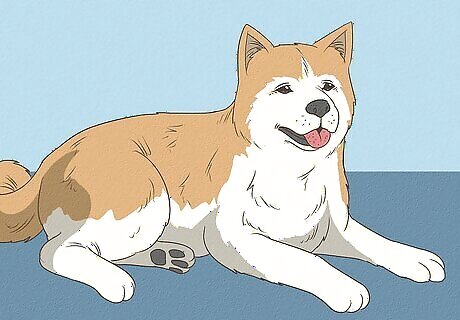
Encourage calm 'default' behaviors. Default behaviors are things your dog does when he doesn't know what else to do. If your dog is hyperactive whenever he's not in his crate, this probably means that his default behavior is to run around, jump, bark, or whatever. Work on transforming his default behavior to something that requires being calm (such as sitting down). This requires frequently rewarding your dog for doing whatever it is that you want his default behavior to be. Use a very small treat as the reward, and give one to him whenever he engages in this behavior on his own. It is okay if you want your dog's default behavior to be something you can also command him to do; just be sure to make the distinction in your training by not providing the command when reinforcing his default behavior.

Remove temptations. You can help promote calm behavior in your dog by eliminating as many potential temptations as possible from the indoor spaces your dog frequently visits. For example: don't leave shoes lying around if your dog is a shoe-eater; close your child's bedroom door so he can't steal her toys; don't leave unattended food on tables your dog can reach. Testing your dog's willpower will usually turn out badly. In cases where you witness your dog resist temptation (for example, he walks right past that piece of chicken sitting on the dining table), you should take the opportunity to reward and praise your dog. This is about using common sense; dogs are intuitive, but they are not self-aware. No matter how well-behaved your dog is, you can't expect him to behave perfectly. Help him out where you can!
Keeping Your Dog Calm Outside
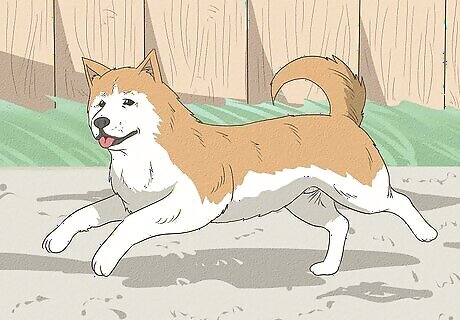
Exercise your dog. A dog that is well-exercised is unlikely to be hyperactive otherwise. However, there is a fine line between exercising your dog and riling him up. Walks are a good way to get rid of pent-up energy, and so are games like fetch. Just make sure you aren't encouraging your dog to go crazy while engaging in these activities. It is important that your dog gets physical exercise every day. How much exercise and how strenuous depends on your dog's age, breed, and health. Visit the American Kennel Club's breed description website to learn about your dog's needs. Your dog should receive regular mental exercise, too. You can even incorporate this into his dinner time by making him work for his food (by putting it in a dispenser or toy designed to release a little at a time).

Avoid dog parks. A crowded dog park is the ultimate context for over-stimulation. It is best to avoid these places altogether while you are training your dog to be calmer and more obedient. Don't deprive your dog of all canine interactions, though; find a playmate for your dog (preferably that of a friend or family member) that is roughly your dog's age, size, and temperament for him to interact on occasion. Prolonged and intense stimulation, such as is experienced at a dog park, may seem like a great outlet for your dog, but in reality this can wind him up and make it more difficult for him to calm down, even long afterward. This advice applies to other situations with lots of people and/or dogs, too (such as parades, festivals, concerts, farmer's markets, etc.).

Train your dog to walk on a leash. If you hope to be able to take your dog out in public without him causing a scene, put significant effort into leash training. A leash provides any easy way to test your dog's tendencies (he'll forget he's on a leash whenever it isn't pulled tight) while allowing you to correct bad behavior. This requires lots of time and patience, and works best if you use treats to reinforce good behavior. Make sure your dog is not already overly excited before you go on your walk. Stand quietly and wait for him to stop barking, spinning, jumping, or whatever before you head outside. Never let the dog pull on the leash. Keep him next to you at all times, and stop walking any time he jolts ahead of you and pulls. Give him a treat when he's paying attention to you and when he's doing a good job of sticking by your side. Use verbal commands such as "heel" or "slow" to signal your dog and reward him when he does what you are asking. Eventually, he will learn what these terms mean and respond accordingly. Walk at a brisk pace at first to make it less difficult for your excited pooch to match your walking speed. You can use quick, sharp jerks of the leash to tell your dog when he is behaving inappropriately -- just make sure you don't pull on it, as this could make him think pulling is okay.
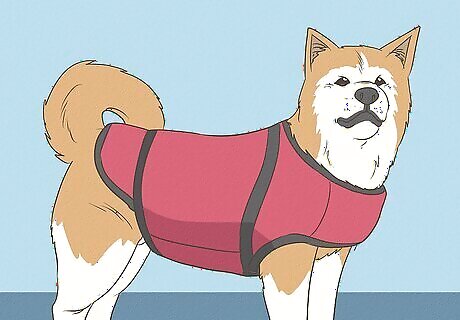
Get your dog a Thundershirt. If your dog's wild behavior is the result of anxiety or nervousness (such as during the Fourth of July fireworks), you can calm him down by having him wear a shirt that gently hugs his body. This mild squeeze has a calming effect on animals (humans included) and is similar to being hugged. This will work best if you do not put your dog's Thundershirt on him unless he is feeling scared or anxious. "Thundershirt" is the name of a trademarked invention; visit their website for more information about their products. Alternatively, you can purchase a regular pet shirt that fits your dog snugly (but not too tightly); these are easy to find at any pet store or online.
Creating a More Obedient Pooch

Enroll your dog in obedience school. If you can afford to do so, look into weekly training courses led by professional animal trainers. Many pet stores offer affordable courses for dogs and their owners. The main benefit of taking these classes is exposure to tried and true training methods; this makes this option ideal for new pet owners. Obedience school sessions can only give you the tools with which to train your dog yourself. Do not think of this as a substitute for doing the work of training; you must work with your dog outside the classroom regularly in order to see results. If you do not already know of training classes near you, search Craigslist or other online community boards for information about local dog obedience courses.
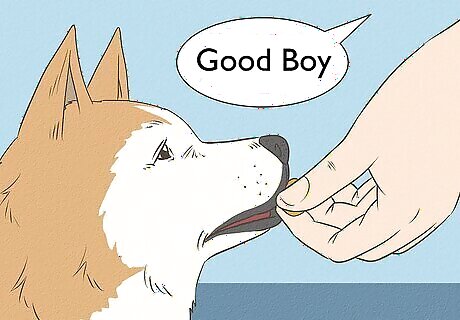
Use lots of praise and rewards. Although some experts differ on their opinions of the best way to train a dog, many argue that positive reinforcement is the key to success. To do this, you must use a system of rewards to teach your dog that what he is doing is good. These can be doggy snacks, physical affection, verbal praise (such as exclaiming "good boy!"), or a combination of these things. For positive reinforcement to work, you must deliver the reward as quickly as possible following the good behavior. If you wait too long between your dog's action and the reward, he won't make the connection between the two. Many people find that using a clicker (a small device that makes a 'click' sound when squeezed) helps dogs associate their good behavior with rewards. Clicker training manuals and equipment can be found at your local pet store or online.
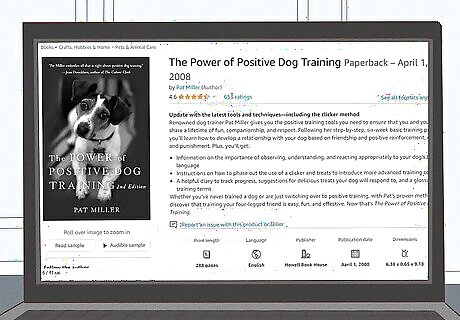
Read a book on dog training. There are lots of books out there devoted to the subject of dog training. These range from basic 'starter manuals' to in-depth analyses of pet psychology. In order to keep things as simple as possible for you and your dog, start out with a guide of some sort with tips you can clearly identify and follow. Be sure to find a book written by an expert on animal behavior. Check the credentials of the author by searching his or her name online.
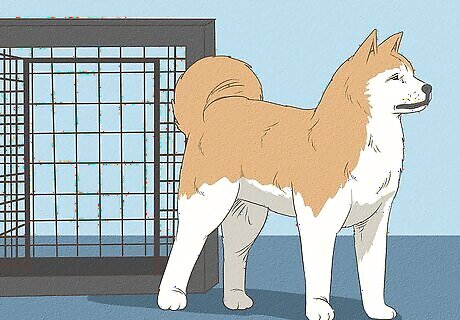
Minimize your dog's crate time. If your dog spends all night and most of the day in a crate by himself, he will be poorly socialized, bored, and have lots of pent up energy. Your dog needs to learn what behavior is acceptable and what is not, and he can't do this by being locked up all the time. An over-crated dog is often so relieved when he is let out that he has trouble containing his exuberance. Crates are best used as training tools for puppies. If at all possible, avoid locking your dog in a crate while you are at work or even overnight. With training, your dog's behavior will be good enough that you can trust him in the house unsupervised. Keep in mind that although a crate can keep your dog from destroying furniture or urinating in the house, it can't keep him from misbehaving altogether. A barking or howling dog is no fun to deal with all the time, and they can still do this from inside a crate.

Teach your dog basic vocal commands. These can include "sit," "down," "stay," "heel," or whatever else you want. Teaching your dog to respond to commands establishes you as his leader and reinforces his tendency to want to pay attention to you. The key to making these commands stick is to use rewards and maintain consistency in their use. For example, don't use "down" to mean both "lie down" and "don't jump." Consider using a leash during vocal command training (even in the house). If your dog disobeys you or won't pay attention, a sharp tug on the leash will serve as a correction. Remember to reward your dog for responding appropriately to your commands (verbal or otherwise), even if this behavior immediately follows a corrective action (such as a leash tug). Otherwise, he will have no reason to obey you!




















Comments
0 comment